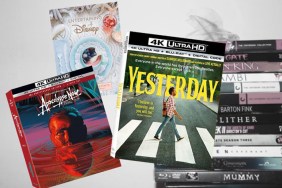Sinister (adj.), early 15c., “prompted by malice or ill-will,” from Old French sinistre meaning “contrary, unfavorable, to the left,” from Latin sinister meaning, literally, “left, on the left side” (opposite of dexter), perhaps from root *sen– and meaning properly “the slower or weaker hand” [Tucker], but Buck suggests it’s a euphemism (see left (adj.)), connected with the root of Sanskrit saniyan “more useful, more advantageous.”
The Latin word was used in augury in the sense of “unlucky, unfavorable” (omens, especially bird flights, seen on the left hand were regarded as portending misfortune), and thus sinister acquired a sense of “harmful, unfavorable, adverse.” This was from Greek influence, reflecting the early Greek practice of facing north when observing omens; in genuine Roman auspices, the left was favorable. Bend (not “bar”) sinister in heraldry indicates illegitimacy and preserves the literal sense of “on the left side.”
-From the Online Eytmology Dictionary
The movie Sinister, a ghost story with Ethan Hawke, about a mysterious serial killer who seems responsible for several generations worth of deaths arrive on home video this Tuesday. the title most certainly alludes to the “unfavorable” definitions above.
According to what I remember from my trips to children’s science centers made in the fourth grade or so, you have about a 10% chance of being born into this world left-handed. Many left-handed children have struggled with being forced to write with their right hand, not out of any sort of sinister or cultural bias, but mostly out of simple odds; apologies to lefties, but your parents probably thought you were a rightie when you were born. I trust you are writing with the comfortable hand these days. Some research has revealed that lefties are high-achieving, although short-lived. Lefties tend to process information more visually than aurally. And, because of the way lefties’ brains are wired, they tend to have a high percentage of creative and intellectual prowess. As such, many famous, brilliant people were born left-handed. 10% of the population may be left-handed, but there is an impressive percentage of famous left-handed people versus famous right-handed people. Four out of the last five presidents were left-handed.
There are numerous databases online citing left-handed actors in Hollywood. Have you ever noticed that while watching a movie? That a southpaw will sign a paper or write a note with their left hand? Once you start noticing, it’s hard to stop. I’ve caught perfect strangers in movie theaters whispering “southpaw.”
Here, then, are ten very famous actors – five ladies and five lads – who are or were left-handed. As Queen Latifah said, ladies first…
Marilyn Monroe (1926 -1962)

What can one say about Marilyn that hasn’t already been stated in biographies, articles, film books, documentaries, and outright biopics? She is probably the world’s most famous actress, more famous, even, than the movies she’s appeared in; more people tend to remember Marilyn for her legend and for the ubiquity of her iconic image… it’s not for noting that Andy Warhol used her face in one of his most famous paintings. Most casual observers have seen precious few of her films (she appeared onscreen in over 30 features), but even little kids seem to know instinctively who she is. A whirlwind bombshell of bubbling 1950s sexuality, Marilyn was two parts ditz, three parts sex, one part joy, four parts tragedy, two parts hilarious, and three parts brilliant. See Some Like it Hot sometime.
Angelina Jolie (1975 – )

Star of over 40 films ranging from goofy schlock like Cyborg²and Hackers, all the way through a few Academy Award-fetching turns in films like Girl, Interrupted and Changeling, Jolie is most certainly one of the world’s current reigning movie stars. In addition to that, Jolie is often considered right at the top of many sexiest-person-alive polls; in a recent poll of UCLA students, Jolie was polled third highest amongst college boys as the celebrity they would most want to bed down with. She was fifth amongst college girls. Not just a gorgeous woman, Jolie exudes a brash and confident sexuality, and I’m not just talking about her happily displayed leg at the last Oscar cast. A humanitarian, wife of an equally powerful movie star, and object of gossip, the woman is a southpaw.
Julia Roberts (1967 – )

Where Jolie is famous for her forthright sexuality, Julia Roberts is known for her sheer overpowering happiness. And while she has starred in her share of darker dramas that show her range as an actress (in Closer she played one of many spitefully unfaithful spouses, in Mary Reilly she was maid to Dr. Jekyll, in Flatliners, she plays a death-obsessed student), but she is, of course, better known for her large spate of cheerful and bright romantic comedies like My Best Friend’s Wedding, Notting Hill, and Runaway Bride. What’s more, any female born after a certain date has seen Pretty Woman. Roberts is one of those movie stars – like Tom Cruise – whose entire career you follow almost without trying. It took Erin Brockovich to get her an Oscar. She is perhaps the golden standard for female movie stardom in America. She signs her enormous paychecks with her left hand.
Nicole Kidman (1967 – )

Born in Hawaii, and raised in Australia, the beanpole redhead of BMX Bandits fame has managed to rise to the role of Hollywood starlet, partly because of her talent and icy beauty, and partly because of her well-documented involvement with Tom Cruise, also left-handed, by the way. Star of nearly 60 films, Kidman has displayed an unusual range for a movie star of her stature. She has won an Academy Award for playing Virginia Woolf (complete with a rubber Woolf nose), but has also played an imaginary version of photographer Diane Arbus, an icy fantasy villainess hellbent on severing children from their souls, a Civil War Penelope, a Stepford Wife, and Samatha from Bewitched. For my money, her best role was as the none-too-bright-but-far-too-calculating would-be new reporter Suzanne Stone in Gus Van Sant’s 1995 media parody To Die For. She polishes her statuette with her left hand.
Judy Garland (1922 – 1969)

Even if you’re not familiar with her amazing music career, even if you’re not familiar with the 30-plus films she was featured in, even if you don’t know about her amazing rise and tragic, drug-related fall, then you at the very least know her for 1939’s The Wizard of Oz, which is, I think I can state without much argument, the most famous and celebrated and quoted film of all time. Garland was a young girl with a big voice, belting out gorgeous ballads with the power of an opera star, but with the pretty innocence of the girl next door. At age 19, she starred in Oz, and to this day, her oft-repeated version of “Somewhere Over the Rainbow” can still bring a tear to the eye of the most staunch of humans. Note which hand she gestures with.
And now, the fellas…
Bruce Willis (1955 – )

His latest flick, A Good Day to Die Hard, opens on Friday, but southpaw Bruce Willis has had a bizarre and far-reaching career that has proven him more than an action hero. He first hit the public eye as the charming romantic lead of Moonlighting, was considered a plausible action star when Die Hard came out in 1988, has lead up comedies like Look Who’s Talking, he played an outright villain in The Jackal, and has acted opposite young versions of himself in both The Kid and Looper. He’s been in obscure cult comedies like Breakfast of Champions based on the Kurt Vonnegut novel, horror films like The Sixth Sense, as well as ginormous clunky summer blockbusters like Armageddon. It’s hard to think of a movie star who has this much range, this much charm, and this much experience. He has starred in nearly 90 feature films. Also he has blues records and music videos. Fun to watch, and affable, Willis is a southpaw to look up to.
Cary Grant (1904 -1986)

One of the original charmers, Cary Grant projected a sophisticated adult charm that modern movie stars seem to lack. Mincing and effete, but strong and watchable, Grant was often seen in movies of the 1940s opposite the most attractive women of the era, bantering, kissing, and matching wits with each one of them with a confidence and bravado that most men can only envy. Completely lacking in swagger, but still managing to be a central symbol of modern masculinity, Cary Grant has starred in thrillers, romances, and comedies, all with equal fervor. Whether he’s the everyman in North by Northwest, the gun-haver in Charade, or in Hitchcock’s best, Notorious, you can’t take your eyes off the guy and his impeccable hair and suits. I’ve heard rumors that he was almost James Bond. He’d stroke your cheek with his left hand.
Charlie Chaplin (1889- 1977)

We probably wouldn’t have movies if it weren’t for Chaplin, at least not as we know it. Sure, most people know his famous “Tramp” character from several of his early comedy films like The Gold Rush and Modern Times and the oft-touted City Lights, but Chaplin is just as notable for his off-screen work as he is for his elegant on-screen slapstick. Chaplin was one of the original United Artists, one of the first major film studios, and a studio that, as the name implies, allowed greater artistic freedom than some of its contemporaries. In the 1920s, he was a comedy champ. By the 1940s, he was stretching into more hard-edged forms of black comedy like The Great Dictator (wherein he spoofed Adolf Hitler, the man who co-opted Chaplin’s famous toothbrush mustache) and the recently rediscovered Monsieur Verdoux. Like Monroe, he is an icon beyond his films.
Mark Hamill (1951 – )

In 1976, a dash handsome young actor with blonde hair, impeccable skin, and a sympathetic face was cast in a film called Star Wars, a film whose history I probably don’t need to go into here. Star Wars was released in 1977, and is, to this very day, one of the most popular films of all time. It didn’t just stir the notion of “pop culture,” it practically invented pop culture as we know it today. Several generations of children were raised by Mark Hamill, Star Wars‘ strapping young hero and aspiring psychic superhero/swordsman. Hamill, of course, went on to a long and varied career, ranging from the low (Corvette Summer) to the prolific and high (it’s likely you’ve heard his voice in any cartoon made after 1997; his most notable voice role being that of The Joker in the “Batman” cartoon shows). In interviews, he is good-humored and cheerful. He seems to know his pop culture clout, and plays with it. He plays with his left hand.
Robert De Niro (1943 – )

It’s hard to think of an actor who is tougher than Robert De Niro. Thanks to his work in the films of Martin Scorsese (he played a raving maniac slowly unripping in Taxi Driver, he played a withering boxer in Raging Bull, he played the pragmatic and impatient “leader” in GoodFellas), Robert De Niro has gained a rightfully-earned reputation as one of the more talented and intense actors of his generation. I first saw him as an abusing stepfather in the biographical film This Boy’s Life, and quickly took samples from his entire career. He played a holy man in The Mission, and the Devil in Angel Heart. He has played criminals, priests, everymen, and even charmers, all with equal fortitude. His later career seems to be a riff on his early career, as films like Meet the Parents andThe Adventures of Rocky and Bullwinkle can attest; he can still be tough, but is wise enough to riff on his image. He has starred in over 90 films. I would cautiously recommend them all. Actually, stay away from Godsend. That one’s pretty awful.








